DIGS O' THE DAY (2007-09-25): GASCOIGNE BLUFF, OLD POST ROAD, OLD TOWN BRUNSWICK
 lordmarcovan
Posts: 44,080 ✭✭✭✭✭
lordmarcovan
Posts: 44,080 ✭✭✭✭✭
DIGS O' THE DAY (2007-09-25): GASCOIGNE BLUFF, OLD POST ROAD, OLD TOWN BRUNSWICK
Well, it was a nice Indian Summer sort of day, and my last full day off this week, so I decided yesterday was the day for a long-overdue treasure hunting trip.
I hadn't been out since spring, preferring to spend the long, steamy summer indoors in the air-conditioning. Now that the heat and humidity have abated somewhat, my thoughts again return to the Great Outdoors. I was also happy to find the long-missing battery charger for my camera, so that was going with me, as well. If nothing else, I would return with some pictures. As you can see, I got a whole lot more pictures than I did treasure, but the snapshots should enable you to virtually travel alongside me as we relive my field trip yesterday. (My apologies to those with dialup connections).
The first stop on yesterday's tour was Gascoigne Bluff on St. Simons Island. As you can see from the historical marker (now itself 51 years old), Gascoigne is a very historical place. On the upper end of the bluff, near the Hamilton Plantation slave cabins, I used to hunt regularly, and dug many relics from the plantation era there. However, in the last year or so, the garden club ladies who oversee the place are not as comfortable with detectorists around, so it is now all but closed to us. For a long time, I had exclusive permission there. So now I am left with the much larger lower bluff, which is not as hot with plantation-era relics, though there are bound to still be some. I had only halfheartedly hunted the lower bluff in the past, since it is liberally strewn with pulltabs and modern trash. But it is a big area, and it's a county park.
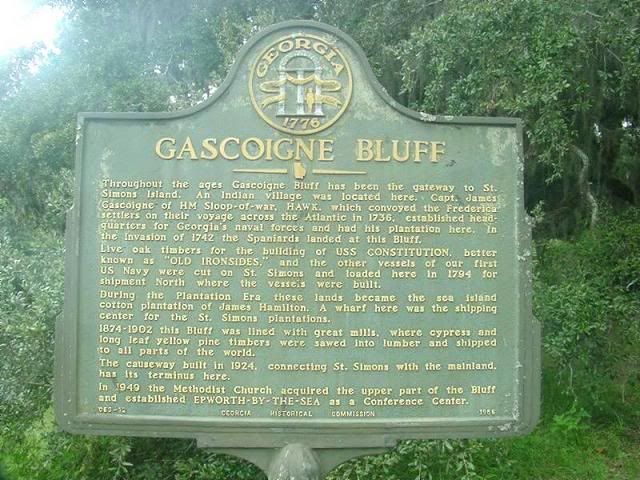
The lower portion of Gascoigne Bluff is a pretty place, as you can see. It has lots of large old moss-strewn live oak trees and big, twisty red cedars. Most of these trees are not quite as old as they look, though- I'm told that they mostly date to the plantation era or later, meaning they're probably 150 years old or less, for the most part. Compared to some live oaks in this area that are 800 to 900 years old, these trees are mere young adults. They've still been here a long time, though. Their shade makes the bluff a pleasant place to visit, and many people jog the track around this part of the bluff, run their dogs, or enjoy the public marina and the brand-new public fishing pier. Back in October of 1999, my wife and I chose to have our wedding reception out here under these oaks, just a short horse-and-carriage ride away from the chapel where we were married. So it's a special place to me.
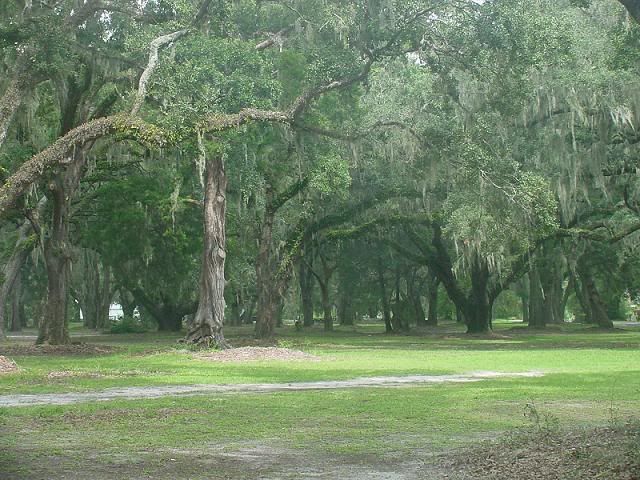
I parked beneath the oaks and unlimbered the detector. In this area, I have started using the "surface elimination" feature on my Garrett GTI-2500 detector, which theoretically ignores the shallower signals. Since I knew that any Spanish, colonial, or plantation era goodies out here are going to be deep, I maxed out the surface elimination, setting it at four inches, the highest setting. This usually means I will get few repeatable signals, and can go a long time before I get a signal I deem worthy of digging. No doubt my selectivity costs me some goodies, but it also saves me a lot of aggravation, and most of the stuff I do dig ends up being deeper, and therefore fairly old.
To my surprise, after I'd walked only a few feet from the van, I got a clear, repeating signal. It registered on the GTI-2500's meter as a Size B (coin-sized) target, at six inches. So I dug, skeptical at first of getting a good signal so soon. In the photo below, you can see just how close to the van I still was.

I had some difficulty pinpointing the target, since both of my electronic pinpointing probes are not working, and I have had to revert to the old manual "grab a handful of dirt and check it" method. But eventually I realized the target was out of the hole, and soon I saw it. It was a coin, a small cent, and obviously an old one.
I do love that olive-green patina an old cent gets in the ground. Most of the Indian cents I dig look like this. For a buyer or seller of US coins, the green patina might not be as pleasing, but for us diggers, it's a nice thing. It's the mark of a nice old coin that's spent a long time in the soil. (This is one reason collectors of ancient Roman and Greek coins also like the green patina).
I could tell this was an early cent. It wasn't an Indian Head- I could see Abe Lincoln on it. So it was a Lincoln cent. I knew it was a Wheatback Lincoln, though, and after some experience with coins, I can usually tell an early Wheatie from a later one, even before I can see the date. The relief is different.
This was plainly an early Wheatie. How 'bout that- this was the first time in a long, long while I'd ever scored on the first target of an outing!
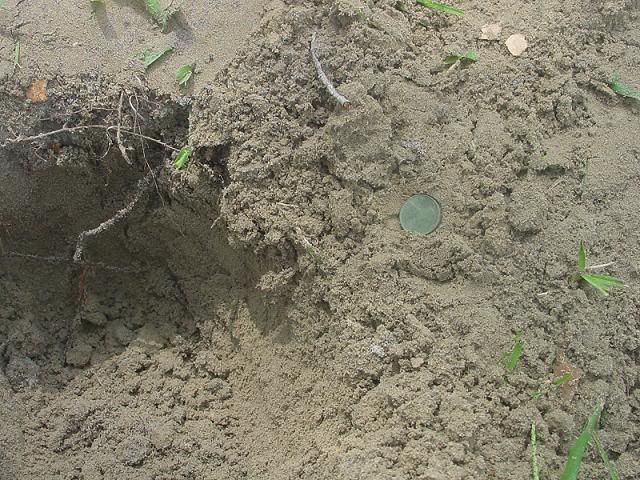
As it happens, this particular early Wheatie is as early as they come, from the first year of issue. A 1909! I thought for a moment the V.D.B. designers initials were on the reverse, too, but upon later examination with a loupe, I didn't see them there. Unfortunately, there's no "S" mintmark, either- it's just a 1909 "plain". Despite the patina and a little corrosion from its time in the ground, you can tell this piece was fairly high grade when it was lost, so I speculate it was probably dropped no later than the 'teens.
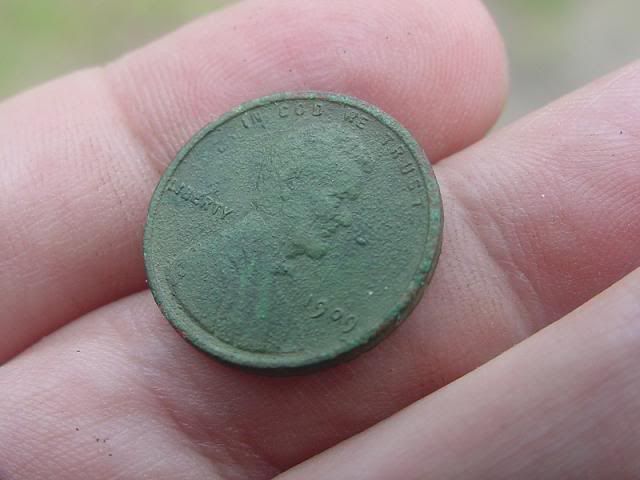
It wasn't a plantation-era coin, but it was darned close to the Indian cent I was hoping for, and an encouraging sign that the lower bluff still has some secrets to reveal. Where there are 1909 Lincoln cents, there are Indian cents. And Barber and Seated Liberty silver. And on this particular bluff, anything is possible, since its history goes back 10,000 years. I am sure there are large cents and Spanish colonial silver reales here. Whether I ever find them or not is another matter- we shall see. So far the only 18th or 19th century artifacts I have found on this part of the bluff were a musket ball and a single flat button from the late 1700s to very early 1800s.
I did not spend much longer on Gascoigne Bluff yesterday, though I should have. I found myself getting tired and sweaty, and after about another hour, I packed up the detector. No doubt my months of inactivity have left me out of shape. My other finds for the hour amounted to an old brass strap end, a 30.06 rifle cartridge, and a pulltab. Except for the pulltab, the targets were all pretty deep and old, so I must be doing something right.
Before leaving, I decided to treat y'all to a scenic shot or two from the new fishing pier.
Here's the entrance to the pier, looking west over the Marshes Of Glynn, toward Brunswick on the mainland.

Here I am, not quite halfway out the pier, looking a little more to the right, over the marshes.

And here's the view closer to the end of the pier, looking back towards the bluff. My van and the area I had just been hunting were concealed by the trees. The wind had kicked up very briskly, and some clouds were appearing in the sky. A gigantic blue heron soared overhead and landed in the mud over near the boats.

I drove back to the mainland, homeward bound. On the way, I noticed this funny sign at a roadside produce stand.
"FRECHS TOMATOES END PEACHS", anyone? Hahaha! That's almost as good as the one I saw that said "WARTMOLLONS 4 SELL"! Funny how the longest word on the sign is the only one spelled correctly. Unlike the good ol' boy selling WARTMOLLONS, though, this lady looked like she might've been Mexican, so if English is her second language, I suppose she can be given a little more literary license.
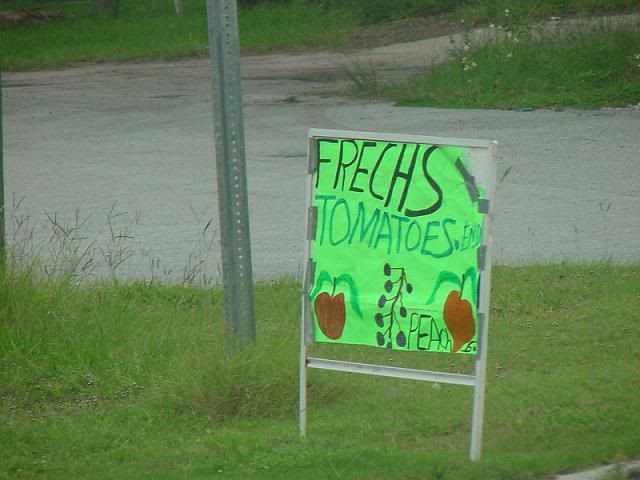
Oh, speaking of silly South Georgia sights, I'll make one more observation, here. Gull-wing doors look cool on a vintage Mercedes or a Delorean, but on a Ford F-150 pickup truck, they look downright dorky. I guess what Jeff Foxworthy said is true: you just can't give rednecks money.
I stopped at a garden supply place on the way home and bought a fancy glazed terracotta planter for ladymarcovan to put flowers in. She's had her eye on those for a while. Forty-two bucks. Yow. Oh, well, it was nice to bring home a little something for the wife. I haven't brought her flowers in a good while, so at least I can bring her something to put flowers in.
After lunch at home, I found myself wanting nothing more than a shower and a nap, but wife and daughter had similar ideas (at least about the nap part), and my side of our bed was fully occupied by daughter and dog. So there was nothing for me to do but go on back out.
This time I thought I would explore the Old Post Road. It's closer to where I live, and forms the western county line between Glynn County where I live, and the neighboring Brantley County, to the west. On a past reconaissance, I had explored up the Post Road to the north, but this time I decided to follow it south, down into Camden County. The Old Post Road, as the name indicates, is a very old road that was once used to carry the mail, as early as the colonial period, well before even the Revolutionary War. On this exploration, I intended to see if there were any timber clearcuts or other likely relic hunting spots recently uncovered by bulldozer activity.
Here's another historical marker from a different part of the Old Post Road, which gives its history. (Not my photo).
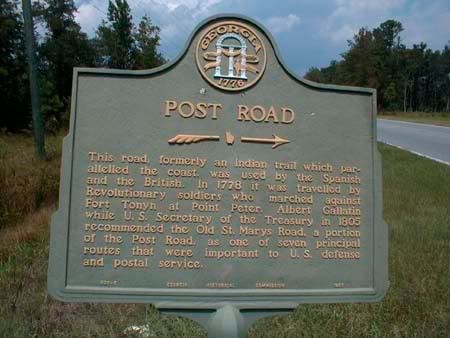
As I headed south along the Old Post Road, I was surprised to find that the pavement ended and for quite a stretch, it was just a sand road, like it no doubt was in the old days. Some old sand roads here can be worth detecting, but because new sand is added to fill potholes and puddles, they're not always productive, and the omnipresent aluminum cans, shotgun shells, and car parts make them frustrating to detect. I wasn't about to waste my time here. One thing I noticed as I rolled along, with nothing but piney woods and palmetto thicket on either side of the road, is that they should call this the Old Post(ED) Road. Practically every fourth tree had a "POSTED, NO TRESSPASSING, HUNTING, OR FISHING" sign on it, along with the requisite dire warnings of prosecution. Ah, well. No likely relic hunting spots here, then.
Eventually, the road ahead had a gate across it, barring further travel into what might be a private hunting club. The road also forked off to the left, and I continued on it, not sure if I was still on the Old Post Road or if it was now a different road. I later discovered I was on Buck Swamp Road.
More miles of piney woods and sand road and nothingness stretched ahead, but in one area, I started noticing chunks of shale-like rock along the shoulders of the road, where they'd added fresh fill dirt to it. Now, fill dirt is anathema to a metal detectorist, because it is usually sterile and free of targets, but my mind immediately shifted gears and kicked into a different kind of treasure hunting discipline.
The chunks of shale rock were my clue, you see. We don't have rocks in the soil here in coastal Georgia. That means one thing: this fill dirt came from dredge spoil material. In other words, stuff that had been dredged up from the bottom of the local ocean sounds and shipping channels, as an aid to navigation. The dredge spoil is often hauled inland and used to resurface sand roadbeds. I have found several fossils in it, including a few nice prehistoric shark teeth.
So I put on the brakes, and slowed down to a crawl. Opening the door to the van, I just rolled along in Drive without touching the gas. Yes indeed, there was a piece of fossilized whalebone- a sure sign that this was fossiliferous sand! Where there are whalebones, there are fossil shark teeth...
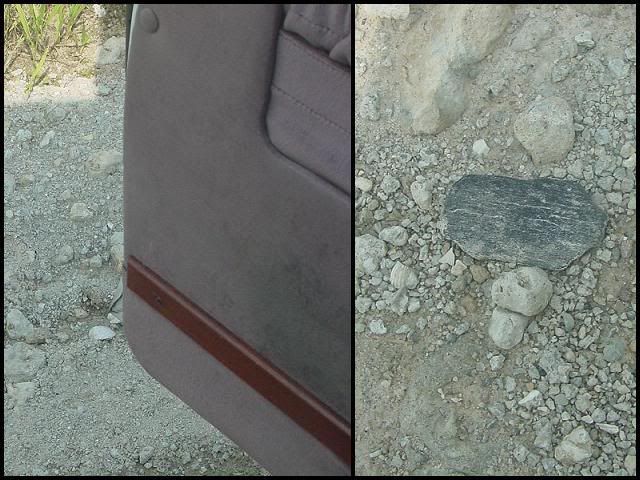
Cruising for fossils, now... what a way to treasure hunt, sitting in the driver's seat of my van, hanging out the open door, with the breeze blowing past and tunes playin' on the radio. The XM "Fine Tuning" channel is wonderfully eclectic- my favorite Bach Brandenburg concerto (the 3rd) was followed by a David Bowie cover of "Across The Universe". (I don't have anything against David Bowie, but I vastly prefer the original Beatles version of that song, which is one of my favorites. Few remakes of Beatles songs have ever cut the mustard, in my opinion.)
I was rolling along slow enough for one of the more persistent horseflies to catch up. He tried to get in the van through the open door, but I discouraged him with a poorly-aimed whack, almost falling out of the slow-moving vehicle in the process. Soon he was left behind and I resumed my scan of the dirt for the glossy black of fossilized material.
Ah! There we go! A shark tooth! A pretty decent-sized one, too. I stopped the van and got out. There it lay, still untouched by human hands for eons. I photographed it before I picked it up. Yep, it was just sitting there pretty like that, fully exposed. It's surprising how often I find them that way. This is why the fossil hunting is best after it's rained.
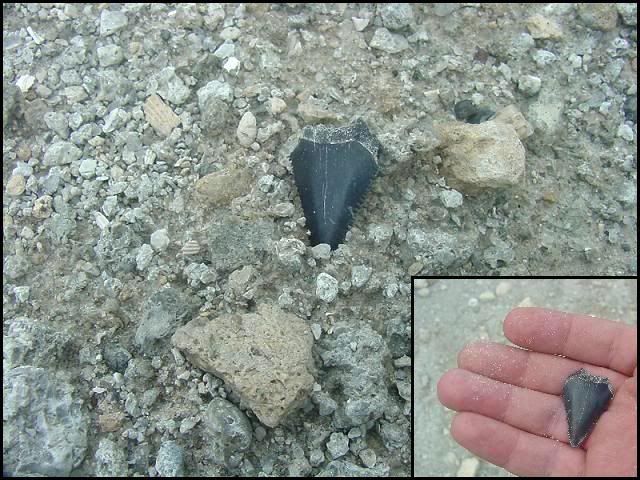
After I picked it up, I could feel the serrations along its edge, just as sharp as they were millions of years ago. I thought it might be an Isuris Hastalis (extinct Mako) tooth at first, because it sort of has that look, but later I read that those don't have serrations. So it's another species, I'm not sure which. There are several like this. It is about the size of the very largest possible Great White Shark tooth today, but Great White teeth are a little more pointy, and of course this is a fossil (a modern, unfossilized shark tooth would be white, not black.)
Finding a tooth this size is a good indication that I might encounter one of my chosen quarry- the tooth of the extinct giant white shark, Carcharocles Megalodon. Megalodon teeth are the most prized, and can be up to almost eight inches long. The largest I've found personally were a little over five inches, about the size of my hand. The sharks these teeth came from grew to the size of boxcars or buses, and preyed upon whales, which is why they're often found in close proximity to whalebone fossils.
But megalodon teeth are not terribly common, at least not while you're driving down dirt roads out in the country, in the middle of nowhere.
Rolling on a few hundred more yards, just before the dredge fill dirt in the road petered out, I spotted another bit of black on the roadside.
Here's what looks like another tooth, again, untouched and unseen by human eyes for millennia. No... longer than that... for millions upon millions of years!
Oh, man... could it be what I think it is...?
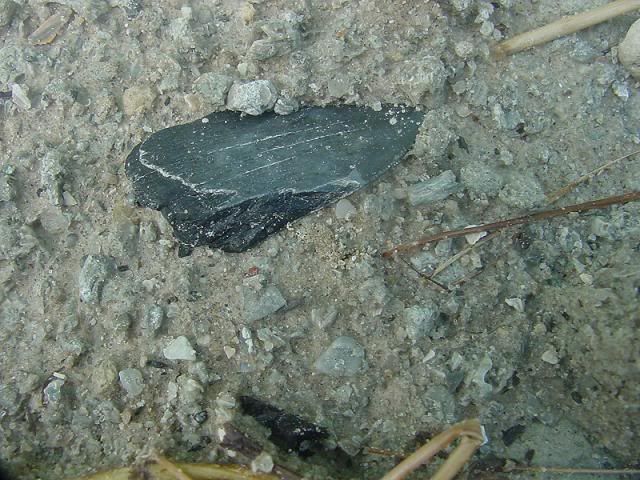
YES!! It's a megalodon!

A smallish and incomplete megalodon, to be sure, but nonetheless the first Meg I have found in a couple of years. This made my day, and is as good as finding a silver coin with my metal detector would have been. The shark who lost this was a small, perhaps juvenile megalodon, maybe only 15-20 feet long. Just think- a "baby Meg" was as big as the largest Great Whites out there in the oceans today. Scary, huh? You can always tell a megalodon tooth, because they're thicker and chunkier than other shark teeth.
My exploratory trip out in the country was fruitless in terms of potential relic hunting sites, but finding fossiliferous fill dirt and two decent shark teeth was a pleasant surprise.
Now into the late afternoon, I found myself wanting to get a little more metal detecting in, so I headed into Old Town Brunswick, to do some sidewalk, median strip, and park hunting, in hopes of maybe getting a silver coin.
Down on the sidewalk strip on First Avenue, I decided to poke around an area I had only partially explored back this spring, near the old city hospital. On the last outing I had found two relatively shallow Wheat cents in the same hole, so I knew this particular sidewalk strip was less picked over. I still chose to use the "Surface Elimination" feature on the detector, but I set it on two inches this time.
Soon I had a nice clear signal. Just as I was digging, I heard a voice from the house behind me, saying "Hello?"
When there's a question mark behind "hello" like that, it's not a good sign.
I looked up and saw a lady standing in her yard.
"Hi, how's it going," I replied.
No answer. I went back to digging, and popped a coin out of the plug, four inches down. It looked like another Wheatie.
"MAY I HELP YOU?"
Oh, geez. These people kill me with that old "May I help you" routine. Do me a favor- if you're going to be a busybody, and inquire what somebody's doing near the edge of your property, just say, "What are you doing", instead of that phony "May I help you".
As I was on the strip between the sidewalk and the street, and on city property, for which I have a permit, and NOT in her yard, I just smiled sweetly to her "may I help you", and replied, "No, thanks, I'm doin' fine."
I went on about my business without looking up at her, figuring I would ignore her until she either found some manners or asked me what I was doing. But I quickened my pace and moved on. It is not worth the time of arguing with people like this about the sidewalk strip in front of their houses. It is city property between the street and sidewalk, to be sure, but lots of homeowners like to claim this as "their" territory, and I guess since they probably mow it and maintain it, it's best just to move on rather than anger them any further. So I moved on. At the corner, safely away from the front of the nosy lady's house, I looked at the coin I had dug. It was another Wheat cent, all right, this time a 1940. Just as I stepped off the curb, I noticed a bald patch in the grass at the corner, and an interesting looking medal lying in the dirt, right on the surface, so I picked it up and then went back to the van.
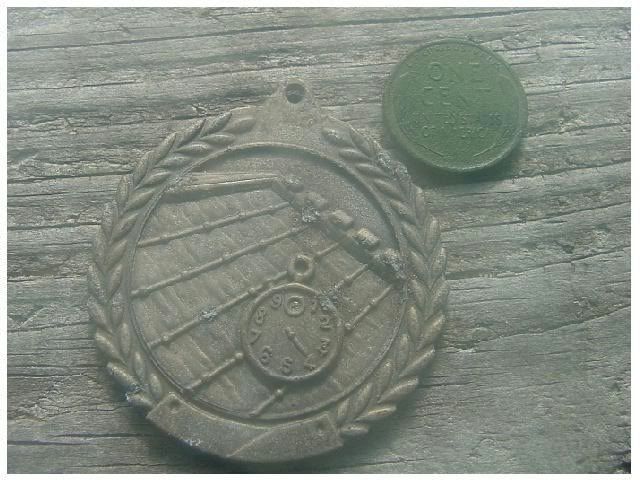
I couldn't make heads or tails of the medal, though it was obviously modern (Made in China). It looked like a skyscraper and a pocket watch with one hand. Later, my wife figured it out- it was a picture of a swimming pool and a stopwatch, so it was obviously a swimming medal of some sort, and once had had a thin gold plating.
The rest of the afternoon I spent hopping around sidewalk strips, medians, and parks in Old Town, but aside from a corroded zinc cent, a small brass fastener, and a piece of copper wire, the results were fairly unimpressive.
That ended my digging adventure. I didn't get "silvered" as I'd hoped, and the day's tally stood at two Wheaties, two shark teeth and a cheap modern swimming medal, but I had a lot of fun, and I hope you enjoyed the story and the pictures. Two out of three coins found were old, as were most of my targets, so my selective digging worked- I didn't end the day with a pocket full of trash.
It was a nice day, and the mosquitoes weren't bad at all. It was still a little hot for my tastes, with the temps getting as high as the mid-eighties, but I can tell that fine fall weather is on the way.
I'll keep you posted the next time I "put the coil to the soil".
~RWS
INDEX OF DIG STORIES
Well, it was a nice Indian Summer sort of day, and my last full day off this week, so I decided yesterday was the day for a long-overdue treasure hunting trip.
I hadn't been out since spring, preferring to spend the long, steamy summer indoors in the air-conditioning. Now that the heat and humidity have abated somewhat, my thoughts again return to the Great Outdoors. I was also happy to find the long-missing battery charger for my camera, so that was going with me, as well. If nothing else, I would return with some pictures. As you can see, I got a whole lot more pictures than I did treasure, but the snapshots should enable you to virtually travel alongside me as we relive my field trip yesterday. (My apologies to those with dialup connections).
The first stop on yesterday's tour was Gascoigne Bluff on St. Simons Island. As you can see from the historical marker (now itself 51 years old), Gascoigne is a very historical place. On the upper end of the bluff, near the Hamilton Plantation slave cabins, I used to hunt regularly, and dug many relics from the plantation era there. However, in the last year or so, the garden club ladies who oversee the place are not as comfortable with detectorists around, so it is now all but closed to us. For a long time, I had exclusive permission there. So now I am left with the much larger lower bluff, which is not as hot with plantation-era relics, though there are bound to still be some. I had only halfheartedly hunted the lower bluff in the past, since it is liberally strewn with pulltabs and modern trash. But it is a big area, and it's a county park.

The lower portion of Gascoigne Bluff is a pretty place, as you can see. It has lots of large old moss-strewn live oak trees and big, twisty red cedars. Most of these trees are not quite as old as they look, though- I'm told that they mostly date to the plantation era or later, meaning they're probably 150 years old or less, for the most part. Compared to some live oaks in this area that are 800 to 900 years old, these trees are mere young adults. They've still been here a long time, though. Their shade makes the bluff a pleasant place to visit, and many people jog the track around this part of the bluff, run their dogs, or enjoy the public marina and the brand-new public fishing pier. Back in October of 1999, my wife and I chose to have our wedding reception out here under these oaks, just a short horse-and-carriage ride away from the chapel where we were married. So it's a special place to me.

I parked beneath the oaks and unlimbered the detector. In this area, I have started using the "surface elimination" feature on my Garrett GTI-2500 detector, which theoretically ignores the shallower signals. Since I knew that any Spanish, colonial, or plantation era goodies out here are going to be deep, I maxed out the surface elimination, setting it at four inches, the highest setting. This usually means I will get few repeatable signals, and can go a long time before I get a signal I deem worthy of digging. No doubt my selectivity costs me some goodies, but it also saves me a lot of aggravation, and most of the stuff I do dig ends up being deeper, and therefore fairly old.
To my surprise, after I'd walked only a few feet from the van, I got a clear, repeating signal. It registered on the GTI-2500's meter as a Size B (coin-sized) target, at six inches. So I dug, skeptical at first of getting a good signal so soon. In the photo below, you can see just how close to the van I still was.

I had some difficulty pinpointing the target, since both of my electronic pinpointing probes are not working, and I have had to revert to the old manual "grab a handful of dirt and check it" method. But eventually I realized the target was out of the hole, and soon I saw it. It was a coin, a small cent, and obviously an old one.
I do love that olive-green patina an old cent gets in the ground. Most of the Indian cents I dig look like this. For a buyer or seller of US coins, the green patina might not be as pleasing, but for us diggers, it's a nice thing. It's the mark of a nice old coin that's spent a long time in the soil. (This is one reason collectors of ancient Roman and Greek coins also like the green patina).
I could tell this was an early cent. It wasn't an Indian Head- I could see Abe Lincoln on it. So it was a Lincoln cent. I knew it was a Wheatback Lincoln, though, and after some experience with coins, I can usually tell an early Wheatie from a later one, even before I can see the date. The relief is different.
This was plainly an early Wheatie. How 'bout that- this was the first time in a long, long while I'd ever scored on the first target of an outing!

As it happens, this particular early Wheatie is as early as they come, from the first year of issue. A 1909! I thought for a moment the V.D.B. designers initials were on the reverse, too, but upon later examination with a loupe, I didn't see them there. Unfortunately, there's no "S" mintmark, either- it's just a 1909 "plain". Despite the patina and a little corrosion from its time in the ground, you can tell this piece was fairly high grade when it was lost, so I speculate it was probably dropped no later than the 'teens.

It wasn't a plantation-era coin, but it was darned close to the Indian cent I was hoping for, and an encouraging sign that the lower bluff still has some secrets to reveal. Where there are 1909 Lincoln cents, there are Indian cents. And Barber and Seated Liberty silver. And on this particular bluff, anything is possible, since its history goes back 10,000 years. I am sure there are large cents and Spanish colonial silver reales here. Whether I ever find them or not is another matter- we shall see. So far the only 18th or 19th century artifacts I have found on this part of the bluff were a musket ball and a single flat button from the late 1700s to very early 1800s.
I did not spend much longer on Gascoigne Bluff yesterday, though I should have. I found myself getting tired and sweaty, and after about another hour, I packed up the detector. No doubt my months of inactivity have left me out of shape. My other finds for the hour amounted to an old brass strap end, a 30.06 rifle cartridge, and a pulltab. Except for the pulltab, the targets were all pretty deep and old, so I must be doing something right.
Before leaving, I decided to treat y'all to a scenic shot or two from the new fishing pier.
Here's the entrance to the pier, looking west over the Marshes Of Glynn, toward Brunswick on the mainland.

Here I am, not quite halfway out the pier, looking a little more to the right, over the marshes.

And here's the view closer to the end of the pier, looking back towards the bluff. My van and the area I had just been hunting were concealed by the trees. The wind had kicked up very briskly, and some clouds were appearing in the sky. A gigantic blue heron soared overhead and landed in the mud over near the boats.

I drove back to the mainland, homeward bound. On the way, I noticed this funny sign at a roadside produce stand.
"FRECHS TOMATOES END PEACHS", anyone? Hahaha! That's almost as good as the one I saw that said "WARTMOLLONS 4 SELL"! Funny how the longest word on the sign is the only one spelled correctly. Unlike the good ol' boy selling WARTMOLLONS, though, this lady looked like she might've been Mexican, so if English is her second language, I suppose she can be given a little more literary license.

Oh, speaking of silly South Georgia sights, I'll make one more observation, here. Gull-wing doors look cool on a vintage Mercedes or a Delorean, but on a Ford F-150 pickup truck, they look downright dorky. I guess what Jeff Foxworthy said is true: you just can't give rednecks money.
I stopped at a garden supply place on the way home and bought a fancy glazed terracotta planter for ladymarcovan to put flowers in. She's had her eye on those for a while. Forty-two bucks. Yow. Oh, well, it was nice to bring home a little something for the wife. I haven't brought her flowers in a good while, so at least I can bring her something to put flowers in.
After lunch at home, I found myself wanting nothing more than a shower and a nap, but wife and daughter had similar ideas (at least about the nap part), and my side of our bed was fully occupied by daughter and dog. So there was nothing for me to do but go on back out.
This time I thought I would explore the Old Post Road. It's closer to where I live, and forms the western county line between Glynn County where I live, and the neighboring Brantley County, to the west. On a past reconaissance, I had explored up the Post Road to the north, but this time I decided to follow it south, down into Camden County. The Old Post Road, as the name indicates, is a very old road that was once used to carry the mail, as early as the colonial period, well before even the Revolutionary War. On this exploration, I intended to see if there were any timber clearcuts or other likely relic hunting spots recently uncovered by bulldozer activity.
Here's another historical marker from a different part of the Old Post Road, which gives its history. (Not my photo).

As I headed south along the Old Post Road, I was surprised to find that the pavement ended and for quite a stretch, it was just a sand road, like it no doubt was in the old days. Some old sand roads here can be worth detecting, but because new sand is added to fill potholes and puddles, they're not always productive, and the omnipresent aluminum cans, shotgun shells, and car parts make them frustrating to detect. I wasn't about to waste my time here. One thing I noticed as I rolled along, with nothing but piney woods and palmetto thicket on either side of the road, is that they should call this the Old Post(ED) Road. Practically every fourth tree had a "POSTED, NO TRESSPASSING, HUNTING, OR FISHING" sign on it, along with the requisite dire warnings of prosecution. Ah, well. No likely relic hunting spots here, then.
Eventually, the road ahead had a gate across it, barring further travel into what might be a private hunting club. The road also forked off to the left, and I continued on it, not sure if I was still on the Old Post Road or if it was now a different road. I later discovered I was on Buck Swamp Road.
More miles of piney woods and sand road and nothingness stretched ahead, but in one area, I started noticing chunks of shale-like rock along the shoulders of the road, where they'd added fresh fill dirt to it. Now, fill dirt is anathema to a metal detectorist, because it is usually sterile and free of targets, but my mind immediately shifted gears and kicked into a different kind of treasure hunting discipline.
The chunks of shale rock were my clue, you see. We don't have rocks in the soil here in coastal Georgia. That means one thing: this fill dirt came from dredge spoil material. In other words, stuff that had been dredged up from the bottom of the local ocean sounds and shipping channels, as an aid to navigation. The dredge spoil is often hauled inland and used to resurface sand roadbeds. I have found several fossils in it, including a few nice prehistoric shark teeth.
So I put on the brakes, and slowed down to a crawl. Opening the door to the van, I just rolled along in Drive without touching the gas. Yes indeed, there was a piece of fossilized whalebone- a sure sign that this was fossiliferous sand! Where there are whalebones, there are fossil shark teeth...

Cruising for fossils, now... what a way to treasure hunt, sitting in the driver's seat of my van, hanging out the open door, with the breeze blowing past and tunes playin' on the radio. The XM "Fine Tuning" channel is wonderfully eclectic- my favorite Bach Brandenburg concerto (the 3rd) was followed by a David Bowie cover of "Across The Universe". (I don't have anything against David Bowie, but I vastly prefer the original Beatles version of that song, which is one of my favorites. Few remakes of Beatles songs have ever cut the mustard, in my opinion.)
I was rolling along slow enough for one of the more persistent horseflies to catch up. He tried to get in the van through the open door, but I discouraged him with a poorly-aimed whack, almost falling out of the slow-moving vehicle in the process. Soon he was left behind and I resumed my scan of the dirt for the glossy black of fossilized material.
Ah! There we go! A shark tooth! A pretty decent-sized one, too. I stopped the van and got out. There it lay, still untouched by human hands for eons. I photographed it before I picked it up. Yep, it was just sitting there pretty like that, fully exposed. It's surprising how often I find them that way. This is why the fossil hunting is best after it's rained.

After I picked it up, I could feel the serrations along its edge, just as sharp as they were millions of years ago. I thought it might be an Isuris Hastalis (extinct Mako) tooth at first, because it sort of has that look, but later I read that those don't have serrations. So it's another species, I'm not sure which. There are several like this. It is about the size of the very largest possible Great White Shark tooth today, but Great White teeth are a little more pointy, and of course this is a fossil (a modern, unfossilized shark tooth would be white, not black.)
Finding a tooth this size is a good indication that I might encounter one of my chosen quarry- the tooth of the extinct giant white shark, Carcharocles Megalodon. Megalodon teeth are the most prized, and can be up to almost eight inches long. The largest I've found personally were a little over five inches, about the size of my hand. The sharks these teeth came from grew to the size of boxcars or buses, and preyed upon whales, which is why they're often found in close proximity to whalebone fossils.
But megalodon teeth are not terribly common, at least not while you're driving down dirt roads out in the country, in the middle of nowhere.
Rolling on a few hundred more yards, just before the dredge fill dirt in the road petered out, I spotted another bit of black on the roadside.
Here's what looks like another tooth, again, untouched and unseen by human eyes for millennia. No... longer than that... for millions upon millions of years!
Oh, man... could it be what I think it is...?

YES!! It's a megalodon!

A smallish and incomplete megalodon, to be sure, but nonetheless the first Meg I have found in a couple of years. This made my day, and is as good as finding a silver coin with my metal detector would have been. The shark who lost this was a small, perhaps juvenile megalodon, maybe only 15-20 feet long. Just think- a "baby Meg" was as big as the largest Great Whites out there in the oceans today. Scary, huh? You can always tell a megalodon tooth, because they're thicker and chunkier than other shark teeth.
My exploratory trip out in the country was fruitless in terms of potential relic hunting sites, but finding fossiliferous fill dirt and two decent shark teeth was a pleasant surprise.
Now into the late afternoon, I found myself wanting to get a little more metal detecting in, so I headed into Old Town Brunswick, to do some sidewalk, median strip, and park hunting, in hopes of maybe getting a silver coin.
Down on the sidewalk strip on First Avenue, I decided to poke around an area I had only partially explored back this spring, near the old city hospital. On the last outing I had found two relatively shallow Wheat cents in the same hole, so I knew this particular sidewalk strip was less picked over. I still chose to use the "Surface Elimination" feature on the detector, but I set it on two inches this time.
Soon I had a nice clear signal. Just as I was digging, I heard a voice from the house behind me, saying "Hello?"
When there's a question mark behind "hello" like that, it's not a good sign.
I looked up and saw a lady standing in her yard.
"Hi, how's it going," I replied.
No answer. I went back to digging, and popped a coin out of the plug, four inches down. It looked like another Wheatie.
"MAY I HELP YOU?"
Oh, geez. These people kill me with that old "May I help you" routine. Do me a favor- if you're going to be a busybody, and inquire what somebody's doing near the edge of your property, just say, "What are you doing", instead of that phony "May I help you".
As I was on the strip between the sidewalk and the street, and on city property, for which I have a permit, and NOT in her yard, I just smiled sweetly to her "may I help you", and replied, "No, thanks, I'm doin' fine."
I went on about my business without looking up at her, figuring I would ignore her until she either found some manners or asked me what I was doing. But I quickened my pace and moved on. It is not worth the time of arguing with people like this about the sidewalk strip in front of their houses. It is city property between the street and sidewalk, to be sure, but lots of homeowners like to claim this as "their" territory, and I guess since they probably mow it and maintain it, it's best just to move on rather than anger them any further. So I moved on. At the corner, safely away from the front of the nosy lady's house, I looked at the coin I had dug. It was another Wheat cent, all right, this time a 1940. Just as I stepped off the curb, I noticed a bald patch in the grass at the corner, and an interesting looking medal lying in the dirt, right on the surface, so I picked it up and then went back to the van.

I couldn't make heads or tails of the medal, though it was obviously modern (Made in China). It looked like a skyscraper and a pocket watch with one hand. Later, my wife figured it out- it was a picture of a swimming pool and a stopwatch, so it was obviously a swimming medal of some sort, and once had had a thin gold plating.
The rest of the afternoon I spent hopping around sidewalk strips, medians, and parks in Old Town, but aside from a corroded zinc cent, a small brass fastener, and a piece of copper wire, the results were fairly unimpressive.
That ended my digging adventure. I didn't get "silvered" as I'd hoped, and the day's tally stood at two Wheaties, two shark teeth and a cheap modern swimming medal, but I had a lot of fun, and I hope you enjoyed the story and the pictures. Two out of three coins found were old, as were most of my targets, so my selective digging worked- I didn't end the day with a pocket full of trash.
It was a nice day, and the mosquitoes weren't bad at all. It was still a little hot for my tastes, with the temps getting as high as the mid-eighties, but I can tell that fine fall weather is on the way.
I'll keep you posted the next time I "put the coil to the soil".
~RWS
INDEX OF DIG STORIES
Collector since 1976. On the CU forums here since 2001.
0
Comments
Dan
I agree with your fossil Vs. silver statement. The tiny tooth I found, on my Georgia visit, has a home in my top finds folder.
One time I received that phrase while hitting a parking strip, and I think my reply was "I don't think so," but then I kindly and quickly bombarded the person with information (parking strip wasn't even in front of his house, but actually a vacant lot)... Told him I had the local permits, started telling him what I was doing, what I find, etc. and sort of had my "salesman hat" on trying to explain how much I enjoy the hobby (this has defused many similar situations while detecting). So, the guy sort of sheepishly said "oh," and started slowly backing up and walking away while I was still talking. (another rude move by him, but I was glad his angry look was gone as he left) Never really thought about how that phrase "may I help you" is sometimes being used in a rude way.
Thanks for the post... great story and pics.
Hope you can get out again soon and that the next hunt holds some silver (and/or gold) for you...
G.
Again excellent finds.
But there's a hook, see. You gotta post over on my Treasure Hunting Forum.
Post #11 on that thread also gives the particulars. But it's pretty simple. All you gotta do is reply to the thread over there. Let me know what your CU forum ID is, if you use a different one over there.
Collector since 1976. On the CU forums here since 2001.
It gets to the point where you just want to clunk them in the head with your binoculars and continue with your business...but you've got to be polite...grr
When I login I get:
>Sorry, you do not have permission to view this forum...<
Edit: Never mind...I got in.
Jerry
<< <i>Geeze, I got the "May ah heyulp yew?" routine just about every day of my (urban bird) field work this summer. I was making bird observations from the roadside in residential developments and at least once or twice a morning, I'd have someone come up and demand to know what the hell I was doing. Never mind that I was standing right next to my truck with a great big UGA logo and the words "BIRD SURVEY IN PROGRESS - PLEASE DO NOT APPROACH SURVEYOR" on a sign on three sides of my vehicle.
It gets to the point where you just want to clunk them in the head with your binoculars and continue with your business...but you've got to be polite...grr >>
That's when you say, "Yeah, you can help me, by gettin' outta my face!"
Collector since 1976. On the CU forums here since 2001.
That's when you say, "Yeah, you can help me, by gettin' outta my face!" >>
Why not try this: Hello, can I detect your yard ;-)
They did the hard part and made contact with you. Walk up to them as you swing the coil...with a little luck you might get a target and be able to tell them ---why look, we have a copper cent at two inch. A quick pop out with your probe and show NO DAMAGE to the lawn!!!!
Could break the ice.
Jerry
Collector since 1976. On the CU forums here since 2001.
Collector since 1976. On the CU forums here since 2001.
BTW, the first (smaller) shark tooth that I found in the story above was a Great White.
My dig outings are recorded on video, these days. (In fact, "Dirty Movie" #05 is about Gascoigne Bluff.)
But I haven't yet made many of them. Maybe when summer goes away, and it cools off some.
Certainly when I get to dig in the UK in November, y'all can expect some more videos and such.
PS- speaking of videos, and of Gascoigne Bluff, you'll want to watch Steve's recent video shot out there, to see how it's really done!
Collector since 1976. On the CU forums here since 2001.